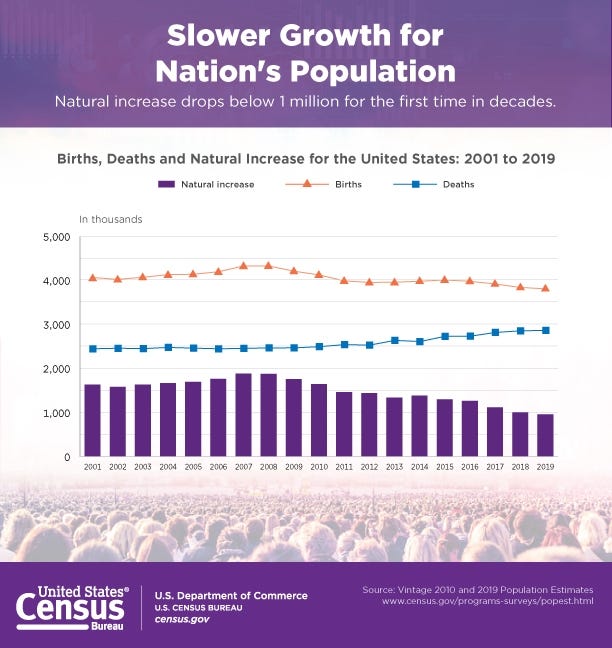
Originally published in Medium by the author
Positioning America to take full advantage of the fourth industrial revolution would require us to take a closer look at the trends driving it that are unique to America. If the last two presidential elections are any indication, the electorate also believes we are heading in the wrong direction.
So let us explore a few trends that are active in our society that we must consider while rebooting the system.
Demographics
Consumers are at the heart of capitalism, and any trend analysis will be incomplete without analyzing what is happening in this space. Every study from the last ten years indicates the following.
Population growth is slowest, uneven and is akin to the great depression

Census Bureau data indicates that most counties are only growing at 0.7%. The average population growth in previous decades was 1% or above. Slowing population growth severely impacts housing, city finances, entrepreneurship, and social justice. Numerous news articles about cities using their police department to aggressively fine motorists are just one example of the impact on social justice.
American Heartlands are emptying.

Counties across the midwest are experiencing significant outflow in the prime working-age population. Multiple factors are driving this trend, some of which include a lack of job or entrepreneurial opportunities, rapid aging of communities, and lack of a supportive regulatory environment. Millennials find it easier to move out of these small cities than stick around and make it work. It also does not help that millennials’ values do not align with these cities.
Productivity Improvements
Automation has been a significant driver in productivity improvements across the previous two centuries. The industrial might of the midwest got decimated in the last two decades by outsourcing and the global market crash. Automation is the silent killer of standard middle-class jobs. The heart of American economic strength was agriculture and industrial goods production. Both have become highly automated in the past two decades. USDA reports suggest significant consolidation in farming and growth in average farm size. These industrial farms are experiencing a 1.5% improvement in productivity over the last 30 years resulting in a 64 % improvement.
Small farms during the same period experienced only 17% improvement. Larger farms can leverage the advances in automated farming tools and the latest in irrigational technologies.
Industrial goods production also shows similar trends where automated assembly lines have significantly reduced the number of workers required for manufacturing.
All these trends have reduced the demand for many traditional jobs in society. No amount of governmental course correction can bring back these jobs. Capital will always look for the easiest path for returns. It’s not naive to look back and long for the glory days of Industrial America, but it’s naive to think that old jobs can be brought back to serve modern society. The capitalistic system that we follow has never worked in that fashion.
What next?
The least discussed component of Heraclitus philosophy of change is the effect of change. If change is a constant, then new opportunities must be its partner in crime.
So let’s take a quick look at these new opportunities. Many of it is shrouded in the fog of change. Although if we examine a few of the trends discussed in this article, the following opportunities emerge.
Health Services for Senior Citizens
We are in the midst of the most significant demographic change. Baby Boomers are retiring (10,000 a day), and millennials are taking over. As part of this trend, the demand for senior care is jumping. The medical expense alone in this segment estimated to be at $2,75,000
Further examination of this generation of senior citizens includes the following characteristics.
· Better Health, aka longer life span
· Racially Diverse
· Working Longer
· Living Alone
This combination brings unique challenges from Medical (Cognitive decline, Alzheimer’s disease, and other age-related issues), Financial and Practical difficulties such as mobility. Being independent also throws care challenges that the family traditionally handled. This will generate demand for new services that could create new automated and manual services. Co-living facilities catering to primary medical care could be driven by remote medical support and monitoring. We still see only some sporadic development in this area.
Smart Cities
Mass immigration to the coasts has proved to be an inadequate management method for coastal towns and cities. Millennial values are forcing the market to develop new solutions in mobility, connected living, and infrastructure management.
Platforms are emerging in open-source space, such as blockchains, to aggregate data and provide opportunities for citizens, entrepreneurs, and organizations to build smart city applications on top of the platform. These data span areas such as
Mobility — Transit, Smart Parking & bike Lanes
Connected Living — Fiber Access, Smart Home/Office, Green Space, Urban Gardens, Data Activation
Infra — Building, Energy, Water, Lighting
Large cities recruiting chief innovation officers is one example of this trend in government.
On a side note, the mismanagement of larger cities has caused a reversal in the flow of people. Many rust belt cities are in the process of reinventing themselves as tech hubs with an abundance of affordable living spaces. Remote work increasingly negates the need to be in one central place to be efficient as a team. One way for the American heartland to recover from its economic blight would be to take advantage of this trend.
The covid pandemic has accelerated this trend. There have been fundamental changes in the market. Remote work has gone mainstream. The business world has seen the benefits or at least has factored in that their workforce need not be concentrated in a specific location to achieve its goals.
A recent survey conducted by PWC highlights this trend.

These opportunities are not limited to large companies. Many large companies are not in a position to risk leveraging some of these new trends. Small startups are in a place to out-innovate and capture the market. This trend is an accelerator for the gig economy. Freedom of choice and association always bring the best out of a market-based economy. If 2020 was an indicator of the untapped opportunity, we must embrace autonomy and take back the reins of our future.
References & Notes
This article is part of a series that explores how to revitalize the American economy.
Feb 28: This article has been updated to reflect a fundamental change brought on by the pandemic.
1. https://www.census.gov/library/visualizations/2019/comm/percent-pop-change-county.html
2. https://www.governing.com/topics/finance/gov-addicted-to-fines.html
4. https://en.wikipedia.org/wiki/Heraclitus
5.https://www.debt.org/medical/senior-options-costs/
6. https://www.pwc.com/us/en/library/covid-19/us-remote-work-survey.html